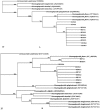Characterization of Haemaphysalis flava (Acari: Ixodidae) from Qingling subspecies of giant panda (Ailuropoda melanoleuca qinlingensis) in Qinling Mountains (Central China) by morphology and molecular markers
- PMID: 23894541
- PMCID: PMC3716770
- DOI: 10.1371/journal.pone.0069793
Characterization of Haemaphysalis flava (Acari: Ixodidae) from Qingling subspecies of giant panda (Ailuropoda melanoleuca qinlingensis) in Qinling Mountains (Central China) by morphology and molecular markers
Abstract
Tick is one of important ectoparasites capable of causing direct damage to their hosts and also acts as vectors of relevant infectious agents. In the present study, the taxa of 10 ticks, collected from Qinling giant pandas (Ailuropoda melanoleuca qinlingensis) in Qinling Mountains of China in April 2010, were determined using morphology and molecular markers (nucleotide ITS2 rDNA and mitochondrial 16S). Microscopic observation demonstrated that the morphological features of these ticks were similar to Haemaphysalis flava. Compared with other Haemaphysalis species, genetic variations between Haemaphysalis collected from A. m. qinlingensis and H. flava were the lowest in ITS2 rDNA and mitochondrial 16S, with sequence differences of 2.06%-2.40% and 1.30%-4.70%, respectively. Phylogenetic relationships showed that all the Haemaphysalis collected from A. m. qinlingensis were grouped with H. flava, further confirmed that the Haemaphysalis sp. is H. flava. This is the first report of ticks in giant panda by combining with morphology and molecular markers. This study also provided evidence that combining morphology and molecular tools provide a valuable and efficient tool for tick identification.
Conflict of interest statement
Figures


References
-
- O’Brien SJ, Pan W, Lü Z (1994) Pandas, people and policy. Nature 369: 179–180. - PubMed
-
- Peng JJ, Jiang ZG, Hu JC (2001) Status and conservation of giant panda (Ailuropoda melanoleuca): a review. Folia Zoologica 50: 81–88.
-
- Species Survival Commission, IUCN (2008) Ailuropoda melanoleuca The World Conservation Union, Gland. Available at http://www.redlist.org/search/details.php?species=712 [accessed in 2013].
-
- Zhang JS, Daszak P, Huang HL, Yang GY, Kilpatrick AM, et al. (2008) Parasite threat to panda conservation. Ecohealth 5: 6–9. - PubMed
-
- Zhang ZH, Wei FW (2006) Giant panda ex-situ conservation theory and practice. Beijing: Science Press (In Chinese).
Publication types
MeSH terms
Substances
LinkOut - more resources
Full Text Sources
Other Literature Sources
Miscellaneous

